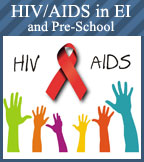HIV/AIDS in Early Intervention and Pre-School On-line Training Course & Examination
Outcomes
Please scroll down for outcomes per discipline and other information, such as Target Audience, Course Content and Level
Course intent: To provide physical therapists, speech language pathologists & occupational therapists, and other early intervention providers with the clinical background to understand the clinically relevant issues regarding HIV/AIDS so that they may comply with State Early Intervention regulations regarding both the privacy of information pertaining to HIV in the child, as well as comply with health and safety requirements for HIV/AIDS.
Relevance to Early Intervention: All therapeutic & interventional providers of early intervention, and especially speech language pathologists and occupational therapists in the early intervention setting must often access the child’s mouth during oral motor, feeding, dysphagia or prompt therapy performed in the early intervention setting; all must know which bodily fluids may carry HIV, and how to appropriately respond to bleeding originating with an infected child, for example, as may occur from a nosebleed.
Outcomes:
Provider will be able to: Identify risk factors, origin, distribution, epidemiology, and modes of transmission of HIV/AIDS for babies
Provider will be able to: Identify modes of HIV/AIDS disease transmission and progression in babies and infants
Provider will be able to: Describe the impact of HIV/AIDS on baby/infant immunity, prognosis, and management.
Provider will be able to: Explain the legal obligation – based upon the State practice acts of each State of health and safety requirement for safety procedures and infection control for babies and toddlers with HIV/AIDS
Provider will be able to: Explain the legal obligation – based upon the State practice acts of each State the release of data regarding for babies and toddlers with HIV/AIDS, in accordance with early intervention guidelines
Provider will be able to: Describe how to manage a situation where an HIV infected child bleeds onto a toy or surface
Provider will be able to: Describe implementation of appropriate clinical infection control procedures, and when such procedures are not appropriate
Provider will be able to: Identify methods and means of appropriate infection control and safety practices with respect to blood-borne infection, as it relates to HIV
Provider will be able to: Identify appropriateness and method of correct transmission or oral and written data regarding the privacy of information relating to HIV/AIDS of a child.
Provider will be able to: Explain the ethical constraints and professional obligations imperative to therapy professional’s vis-à-vis protecting an HIV-infected child’s status.
Speech Language Pathology
Target Audience: Speech Language Pathologists, Speech teachers and Audiologists
Course Level: Various Content: Related
Subject Code: 7060 Patient/Client Safety and Prevention of Medical Errors
AOTA Classification Codes: Category 3: Professional Issues; Legal, Legislative, Regulatory & Reimbursement Issues; Federal & State regulatory Statutes [as related to legal obligation & Good Samaritan laws]; Licensure & Practice Issues [as related to legal obligation & Good Samaritan Laws]
Contemporary Issues and Trends
Ethics
Professional Development and Continuing Competence
Target level: all levels, all practice areas
Course Table Of Contents:
- Introduction
- What is HIV/AIDS
- Where did HIV Originate
- Our Immune System
- HIV's Attack Strategy
- Signs and Symptoms
- Stages of HIV
- Progress of HIV in Children
- Transmission
- Diagnosis and Prognosis
- Prevention
- Treatment
- Q& A







